Bridge BTC will face fierce competition, and token protocols need better development.
Author: @xparadigms & @wowitsjun_(@hashed_official)
Translation: DeepTechFlow
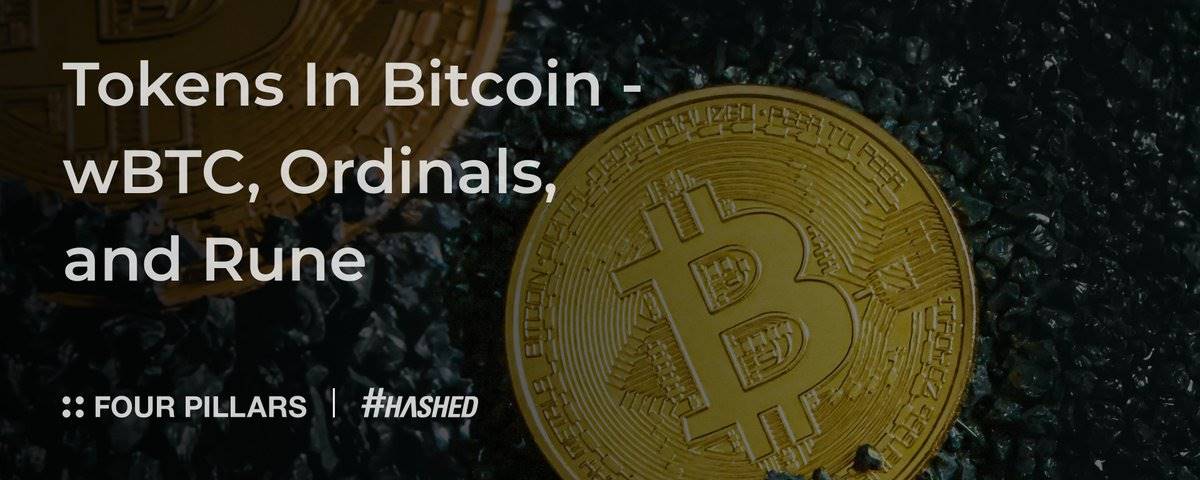
This is the third part of a four-part series of articles exploring solutions for expanding the Bitcoin ecosystem.
In the overall cryptocurrency market, Bitcoin has the most valuable brand and assets, and its asset category is not limited to its native BTC. Bitcoin can not only be packaged and sent to other blockchains for use but also includes Bitcoin-etched assets, such as the Ordinals and Rune protocols. In addition, Bitcoin also has a growing NFT market, with NFTs issued through the Ordinals protocol.
In this opinion article, we will explore the asset categories in the Bitcoin ecosystem and the performance of each asset category.
1. Background - Bridging BTC and Bitcoin Token Protocols
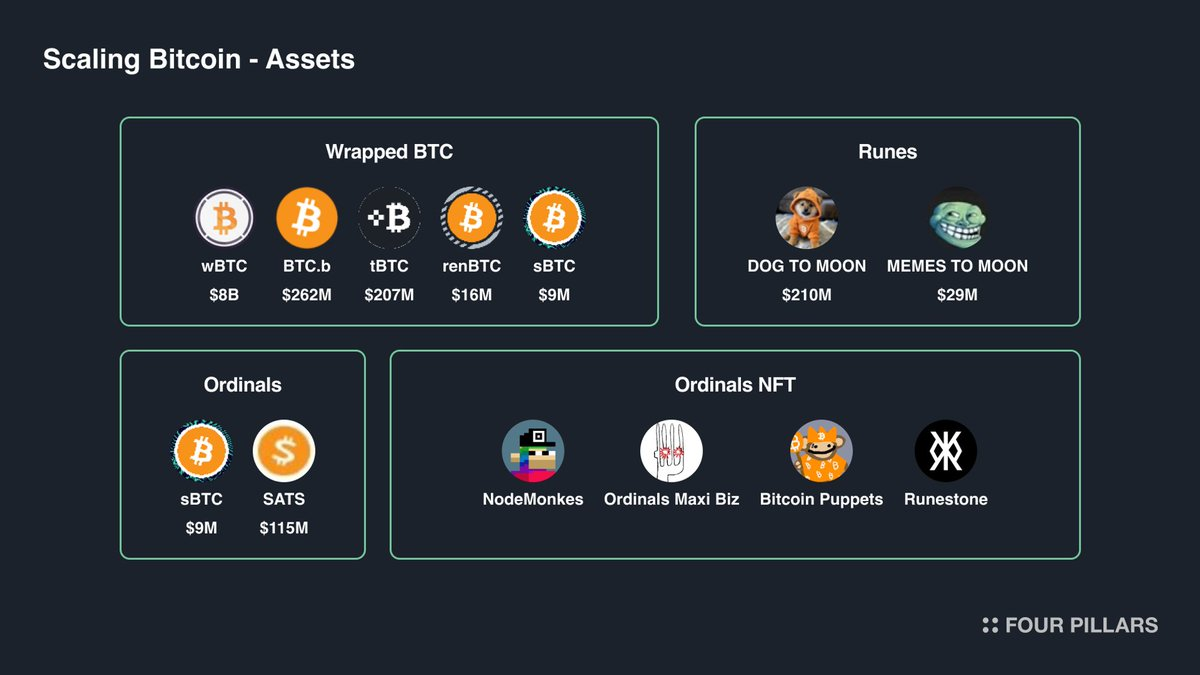
1.1 Bridging BTC
As of 2024, Bitcoin remains the largest cryptocurrency by market value, with a total value exceeding $1.3 trillion, accounting for 53% of the entire crypto market. However, due to the lack of application scenarios for Bitcoin in its native ecosystem, it is bridged to other smart contract-based blockchains, referred to as bridging BTC. Bridging BTC refers to Bitcoin packaged or tokenized at a 1:1 ratio for use in decentralized finance (DeFi) on other blockchain networks.
Examples of bridging BTC include wBTC, tBTC, and BTC.b:
Wrapped Bitcoin (wBTC): Wrapped Bitcoin is an ERC-20 token on the Ethereum blockchain representing Bitcoin. Each wBTC is backed by Bitcoin in reserves at a 1:1 ratio and is currently operated by BitGlobal.
tBTC: It operates through a set of smart contracts and a decentralized network of signers who manage the minting and redemption processes. Users deposit Bitcoin into a multi-signature wallet and, in return, receive an equivalent amount of tBTC on Ethereum.
BTC.b: This is another form of wrapped Bitcoin on Avalanche, serving as the cross-chain token standard for LayerZero.
Among these bridged BTC, wBTC accounts for the majority of the supply and has become the de facto BTC asset in the Ethereum DeFi ecosystem. Recently, BitGo announced a joint venture with Bit Global in Hong Kong and plans to distribute some of the keys of its multi-signature wallet supporting WBTC to Bit Global in Hong Kong. This has sparked debates about the security of wBTC and discussions about potential development of alternative solutions.
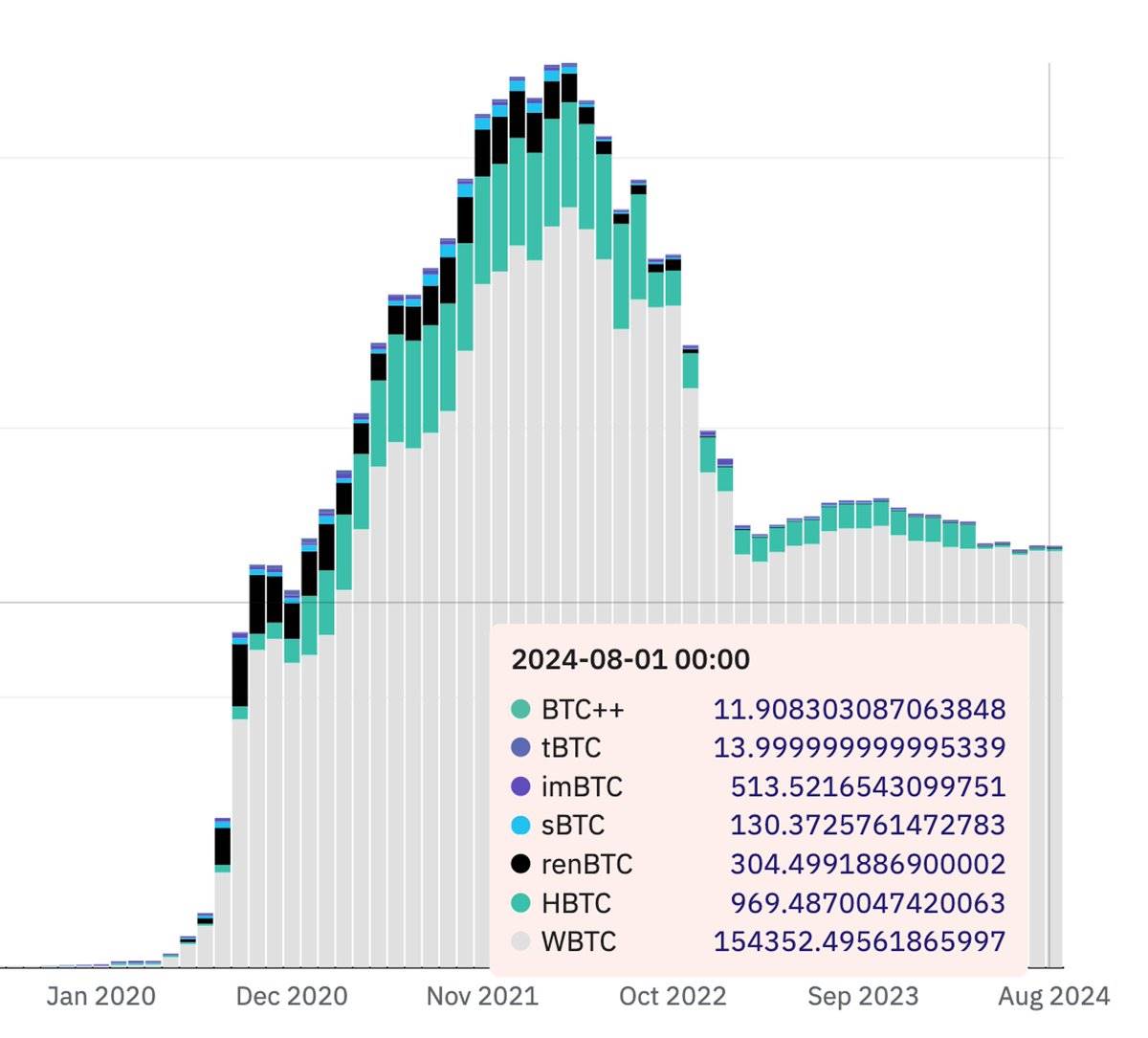
Source: BTC on Ethereum (WBTC, renBTC, etc.)
1.2 Bitcoin Token Protocols - Ordinals and Runes
Bitcoin-etched assets, such as Ordinals and Runes, are protocols directly etched on the Bitcoin blockchain, utilizing its infrastructure for token creation and management. These two protocols, developed by Casey Rodarmor, highlight different use cases of the Bitcoin blockchain, with Ordinals focusing on NFTs and Runes enhancing the scalability of alternative tokens in the Bitcoin ecosystem.
Ordinals Protocol: Launched in January 2023, the Ordinals protocol allows the creation of unique digital assets, namely NFTs or Bitcoin-etched replacement tokens (BRC-20), on the Bitcoin blockchain. The protocol allows users to etch data onto individual satoshis (the smallest unit of Bitcoin), creating a new form of digital collectible. BRC-20 tokens are a token standard similar to Ethereum's ERC-20 but built on the Bitcoin blockchain, and Bitcoin Ordinals are often seen as a form of NFT.
Runes Protocol: This is an alternative token standard utilizing the Bitcoin UTXO model. Unlike the BRC-20 standard, which has led to network congestion due to the surge of "dust" UTXOs, Runes utilizes Bitcoin's inherent UTXO model to create tokens with minimal on-chain footprint. The protocol uses Bitcoin's existing UTXO model and combines it with a script that allows a small amount of data to be included on the blockchain without affecting transaction outputs. The dedicated structure embedded in Bitcoin transaction outputs is called runestones, containing instructions for creating, minting, or transferring tokens. This approach allows for more efficient data storage and reduces the potential risk of network bloat.
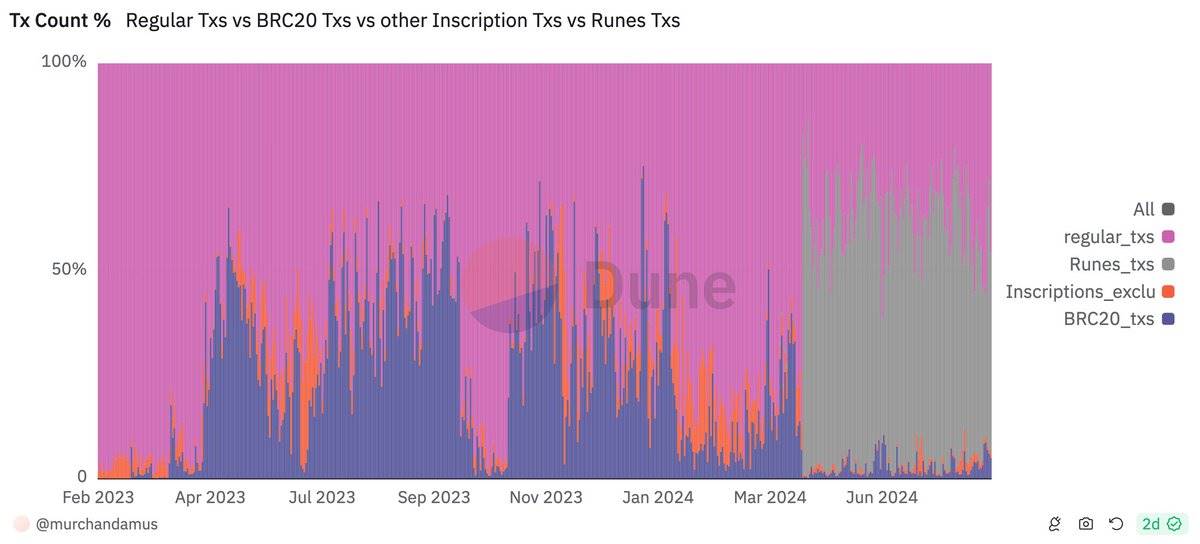
Source: Regular transactions vs. BRC20 transactions vs. other etched transactions vs. Runes transactions
1.3 Ordinals NFT
Over the past year, the Bitcoin NFT market has experienced significant growth, despite a contraction in the broader NFT market. This sector is becoming a significant asset category within the Bitcoin ecosystem, forming a close-knit community.
The expansion of the Bitcoin NFT market is due to the increasing interest in Bitcoin-based NFTs. According to CryptoSlam data, Bitcoin ranks third in historical NFT trade volume divided by blockchain, trailing only Ethereum and Solana.
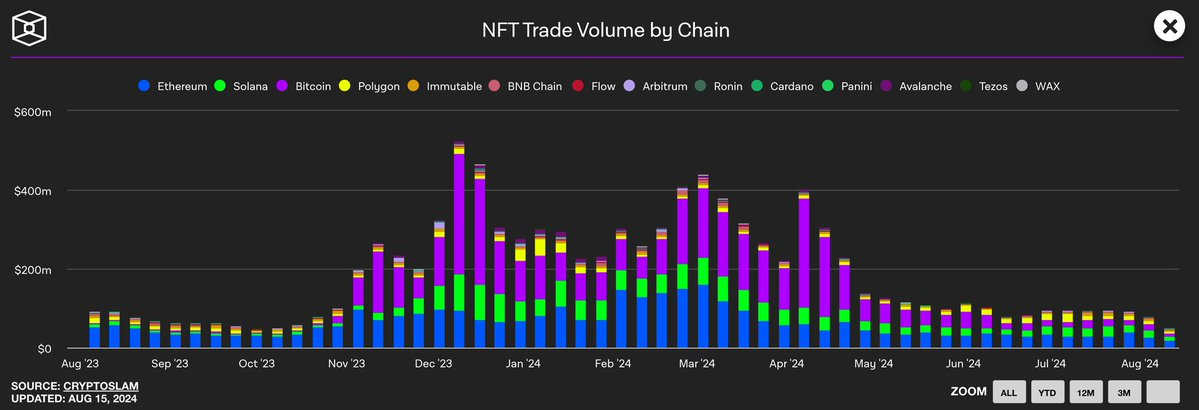
Source: NFT trade volume by chain
- Summary - Bridging BTC will face fierce competition, and token protocols need better development -------------------------------
Author: @xparadigms, from Four Pillars
2.1 About Bridging BTC (e.g., wBTC) - New bridging BTC will face fierce competition
In addition to serving as digital gold for price appreciation, Bitcoin is often sent as bridging BTC to other blockchains for use as collateral or to earn yields in DeFi protocols, especially on Ethereum. This allows DeFi users to easily access BTC.
This week, the operator of wBTC announced plans to transfer partial control to Bit Global, a joint venture co-founded by Justin Sun. In a three-key multi-signature setup, two keys will be handled by Bit Global, and one key will be handled by BitGo. Due to concerns about the "custodial risk" arising from Justin Sun's "reputation risk," as he has not been fully transparent in past projects (such as TUSD and stUSDT), the public is worried. As wBTC accounts for over 95% of Bitcoin assets in Ethereum, this could have a negative impact on the ecosystem if mishandled, potentially leading to discounts compared to other bridging BTC.
Now that this issue has been identified, more projects may attempt to market themselves (e.g., tBTC, BTC.b) and create new wrapped Bitcoins (e.g., Coinbase cbBTC).
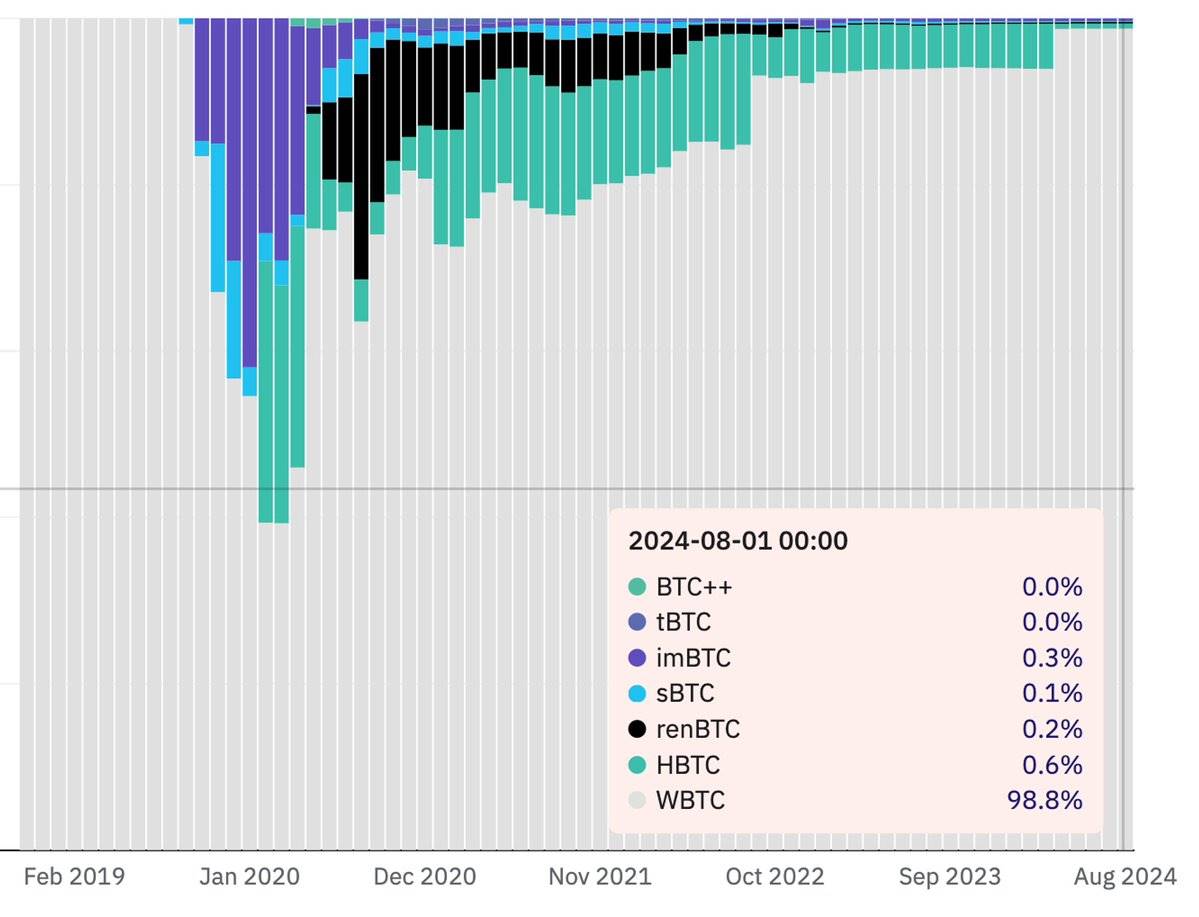
Source: btc on ethereum (WBTC, renBTC, more)
2.2 Bitcoin Token Protocols - "Currently, it's purely community-driven"
Most Bitcoin-etched assets, such as meme coins, lack a way to generate income or appreciation, so they heavily rely on community interest. This means that if market sentiment declines, the overall market may face a collapse. For example, ORDIs do not generate traditional income, and their value mainly comes from market speculation and attention to the Ordinals protocol and BRC-20 tokens. While the use of Ordinals increases transaction fees, benefiting Bitcoin miners, it does not directly generate income for ORDI itself. This reliance on community enthusiasm makes these assets very unstable, and if community interest wanes, their value could quickly plummet.
As Bitcoin Layer 2 (L2) technology develops to improve the user experience in creating and trading Bitcoin tokens, it may attract more attention, similar to launching a pump.fun version on Bitcoin. Further development is still needed for these Bitcoin token protocols to thrive.
免责声明:本文章仅代表作者个人观点,不代表本平台的立场和观点。本文章仅供信息分享,不构成对任何人的任何投资建议。用户与作者之间的任何争议,与本平台无关。如网页中刊载的文章或图片涉及侵权,请提供相关的权利证明和身份证明发送邮件到support@aicoin.com,本平台相关工作人员将会进行核查。




